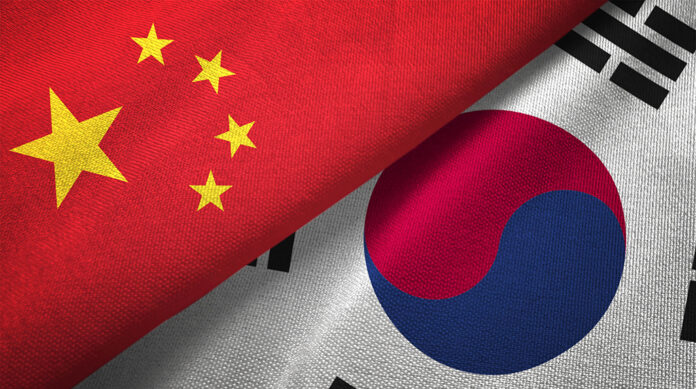For the past year, South Korea’s—and the world’s—two largest memory chip manufacturers, Samsung Electronics and SK hynix, have received a waiver from U.S. legislation restricting imports of U.S. chip-making equipment into China.
Though welcome, the waiver still left uncertainties, militating against long-term investment planning.
The “validated end user” (VEU) status Washington has now granted allows both firms to continue supplying designated U.S. chip-making equipment to their Chinese facilities without penalty or requiring U.S. approval.
Two clauses in the original draft of the CHIPS Act issued in March, which again threatened to limit equipment imports into China, were also amended in the September finalized version of the act’s “guardrails” after strenuous lobbying.
When, on October 18, the United States announced new curbs on supplying cutting-edge artificial intelligence (AI) chips to China that were adverse for manufacturers such as Nvidia, Seoul could say that they would have a limited impact on South Korean firms.
Reasons To Relent
Washington’s easing toward Samsung and SK hynix has three drivers:
Geoeconomics. Some key supply chains, such as memory chips, are so interwoven as to be practically impossible to unravel:
- Samsung and SK hynix dominate worldwide production of memory chips, accounting for 70% of the Dynamic Random Access Memory (DRAM) market and 50% in NAND (flash memory).
- China is a major manufacturing base for both. Samsung makes 40% of its NAND chips in Xian. For SK hynix, 40-50% of its DRAM output, and 20% of NAND, are produced at plants in Wuxi and Dalian, respectively.
Seoul has stressed this, urging Washington to confine its curbs to high-end technologies rather than mundane but vital chips with no military application.
Geopolitics. Given the war in Ukraine and the risk of escalation of the Gaza war, any further moves to destabilize international politics hardly seem prudent. The U.S. decision tacitly acknowledges that this is no time further to unnerve global supply chains.
Samsung is reportedly already upgrading its plant at Xian, its sole site producing memory chips outside South Korea. Opened in 2014, this is the world’s largest NAND factory, making 200,000 12-inch wafers monthly and contributing over 40% of Samsung’s NAND output. Next year, it expands Xian to produce 236-layer (eighth generation) NAND, an investment it would not commit to under its temporary U.S. waiver.
Alliance balance. There are also bilateral motives. Washington’s green light eased a major irritation for Seoul: that Washington was behaving unfairly and high-handedly towards a key regional ally, major trade partner, and host to 28,500 U.S. troops.
In 2021, then-President Moon Jae-in brought the heads of leading chaebol (conglomerates), including Samsung and SK hynix, to his summit with President Joe Biden. They pledged USD39.4bn in fresh U.S. investments, focusing on newly strategic sectors such as semiconductors, EVs and EV batteries. The unstated but clear aim was to build supply chains bypassing China.
Those investments are proceeding, and more have followed. Given that commitment, there was fury in Seoul last year when new EV subsidies in the U.S. Inflation Reduction Act (IRA) excluded Hyundai Motor, a significant investor in the United States but makes its EVs in South Korea.
This episode may have colored the chip decision, with Washington anxious to avoid another dispute with Seoul.
EV Battery Inputs
The next test case will be how Washington treats Chinese-invested electric vehicle (EV) battery ingredient plants in South Korea.
This year, South Korea has attracted at least nine new investments—some joint ventures, others standalone—by Chinese manufacturers of inputs for EV batteries, such as precursors. Their value exceeds USD4.5bn.
Seoul welcomes this as it is eager to build up its own EV and related industries. It wants to avoid future supply-chain crises and secure critical raw materials, many of which come overwhelmingly from China.
For the Chinese side, the main driver is the IRA, which will withhold valuable subsidies from EV and battery makers who source from “foreign entities of concern” (FECs).
They hope that plants sited in South Korea will not be designated FECs, regardless of their ultimate origins or ownership.
However, there has yet to be an agreed definition of an FEC or an acceptable threshold of Chinese involvement.
These investors are gambling that in the EV battery sector, given Beijing’s overwhelming dominance of raw material supply and primary processing, Washington will accept that China cannot be wholly excluded.
Sector Realignment
Meanwhile, the NAND sector may face realignment.
On October 26, SK hynix confirmed its opposition to a planned merger between Japan’s Kioxia (formerly Toshiba Memory) and U.S.-based Western Digital, respectively, the third- and fourth-largest NAND chipmakers.
SK hynix’s consent is needed since it owns 20% of Kioxia, worth USD2.67bn, as part of a consortium led by Bain Capital. With Bain also opposed, the merger cannot proceed.
As SK hynix made a first-half 2023 net loss of USD4.13bn, cashing out of Kioxia could have been tempting.
Yet the merged entity would have a 31.7% market share, behind Samsung’s 33.7%. Despite suggestions that consolidation would ease cut-throat competition, SK hynix (which has 19-20%) wanted to avoid a larger new rival pushing it into third place.
Further, as its stockholding implies, SK hynix wishes to explore its partnerships with Kioxia of its own. The latter will continue cooperating with Western Digital, which also has a stake.
Further mergers and acquisition moves in the sector cannot be ruled out.


